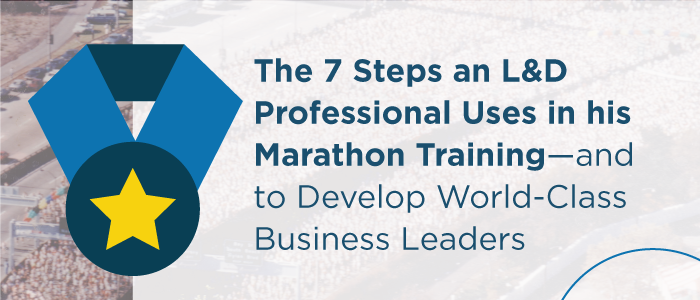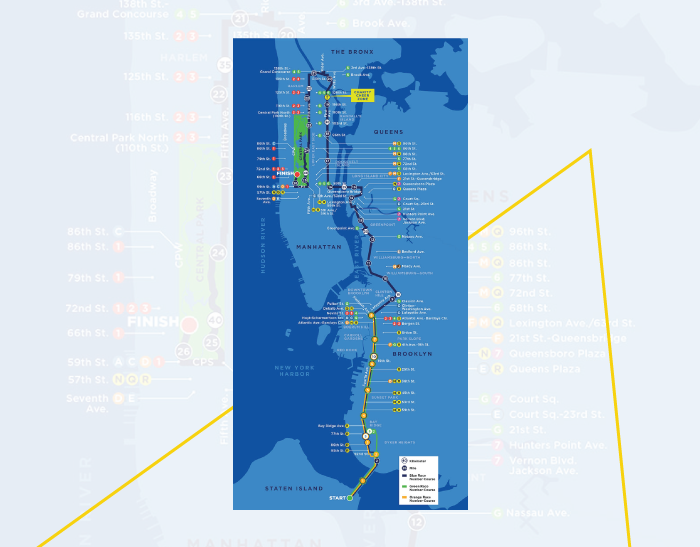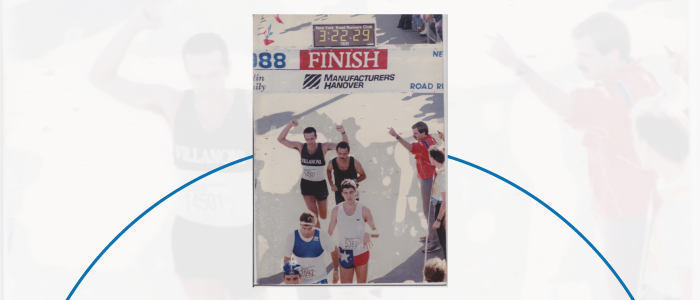7 Steps an L&D Professional Uses in Marathon Training to Develop World-Class Business Leaders
February 26, 2021

Jim Caruso has run five marathons—his fastest finish was in three hours, 11 minutes. That’s a seven-minute, fifteen-second average pace per mile, for 26.2 miles.
That’s nearly as impressive as impacting over 10,000 individuals in 15 countries on five continents from over 100 organizations—including 50 Fortune 500 and Global Fortune 500 companies—across all industries, functions, and talent levels.
Jim blends the two worlds of global talent development and running by using the same guiding principles to train people and prepare for a big race.
After speaking with Jim, we realized the best business training mirrors sports training. How? We’ll show you in seven steps.
Corporate training and marathon training aren’t all that different.
Before his first New York City marathon in 1988, Jim ran shorter distances during his high school track racing days. We’re talking 200-meters, 400-meters, and 800-meters—nowhere near a mile.
To prepare for 26.2 miles, he had to adapt his training approach.
1. Fostering self-awareness and identifying the goal will help you envision the finish line.
Jim was shooting to cross the finish line in about three hours and fifteen minutes. And he had a few months to figure out how to get there.
Many runners line up 5K, 10K, and half-marathon races in their training calendars to simulate tiny legs of the journey leading up toward the big race day.
Professional development may mean striving toward a promotion, switching departments, or understanding your current role in a corporate setting. It may mean achieving a greater understanding of course material or branching out to master a new subject as a student.
In the same manner that athletes need to be self-aware about their abilities to create concrete steps toward achieving their goals in the city streets of New York, L&D Professionals need to know their learners’ skill levels to help set realistic goals and a realistic starting point.
Whether you’re a marathoner, a professional talent developer, or a student, setting goals boils down to the same questions.
Be honest with yourself on where you’re at and be realistic with the challenges you’re facing. What do you need to do to overcome them? And then, identify what you want to achieve.
2. Start with the Basics & Establish a Solid Foundation
After you assess skill levels, set a quality goal, and identify the areas that need to be drilled on to reach it—you build on your base training.
Striding into the three-month marathon training period, Jim started with a solid base of 20-25 running miles a week. Adding extra mileage over time increases V02 max and endurance—just two of many components that help on race day.
Jim paid greater attention to the finer details—nutrition, running drills, and recovery. The little things start adding up. Foam rolling, ice baths, and heat packs were as crucial as running 25 miles a week. Not to mention a decent night’s rest.
Endurance, neuromuscular fitness, and agility accelerate the process of marathon training. Jim likens the base phase of a marathon to generic financial concepts and skills in his career as a global talent development professional.
Before proceeding to more advanced tasks, the first step to practical training is building financial acumen. Individuals need to know the purpose, key components, goals, and drivers of the income statement and balance sheet. Simulations are a great way to apply foundational learning.
Professionals should also define key terms such as revenue, expense, income, profitability, margin, assets, liabilities, equity, efficiency, liquidity, and solvency. Finally, they should be comfortable using various financial statement analysis methods to assess financial management measures.
Ensuring success means defining business goals, creating value, and grasping the basic understanding of financial statements, guided by Jim’s practiced principles of executive leadership development.
Investing in the miles and heavy lifting early on help later down the road when race day comes.
Base preparation also entails preparing for the inevitable injuries. Many runners acquire injuries in the base training phase.
3. Turn challenges into opportunities.
Injuries arise when runners fail to create a solid foundation. Jim had runner’s toe (a black toenail from the repeated stress of running; it happens to the best of us.)
Instead of taking time off, he found ways to build up his foundation otherwise: with cross-training. Instead of pounding New York City’s streets, you could find him deep water running and biking.
“You have the same goal, but your method is going to be different to get there,” Jim said. “You’re going to have a different type of exercise to apply with the result of being in shape and getting your equivalent mileage in.”
Jim turned his injury into an opportunity and embraced cross training by adopting other cardio activities into his training plan to build endurance. Who knew he would pick up a passion for another skillset like biking?
That’s the brilliance of debriefs. They provide learners and participants with feedback for improvement. Debriefing helps encourage critical thinking, goal setting, and planning.
“It provides an appropriate means to put the past behind you while allowing you to grow from the endeavor prior to moving on,” a business culture blog post writes.
Injuries and hindrances toward accomplishing goals pop up outside of marathon situations, too—like after business hours.
Jim advises those in corporate executive education to go the extra mile. He recommends reviewing lessons or slides, asking reflective questions, and peer mentoring others to ensure understanding during a program. Reaching out for an additional conversation with a colleague, boss, or professional and creating new methods can help base knowledge acquisition grow.
Every moment in marathon training has long-term consequences. And when you’re running a business, every decision you make has financial ramifications. A missed practice is one less opportunity to prepare your body for the rigors of a race. In business the question is, how do you replicate that when everything is live? You need to put yourself through those experiences in a safe environment.
4. Apply foundational knowledge in a relevant context.
Jim followed the New York Road Runner’s Club marathon training plan to the tenth of a mile. He built up from his base of 20-25 miles and consistently ran 40 miles a week to strengthen his endurance.
Aside from higher weekly mileage, he began incorporating longer training runs (up to 20 miles) to simulate a portion of the race day. When the big day came around, he already built up the confidence to do the work.
After gaining a foundational understanding of financial statements described earlier, it’s time to apply them with business strategies and connect them back to the learner’s organization to make them more relevant. This includes their financial statements, annual report/10-K, P&L terminology, and metrics.
While a board member for the Association for Business Simulation & Experiential Learning (ABSEL), Jim authored and presented in multiple conferences on redesigning and strengthening the MBA curriculum with the help of simulations and experiential learning.
Whether he was instructing total enterprise simulations with Capsim’s Foundation Simulation or scenario-based solutions for business acumen and leadership strategies, both simulations and real-life approaches involved a similar training base.
“Jim has a strong ability to translate theory into actionable learning that has a direct and positive impact on business strategy,” Tom Sontag, Ph.D., wrote of his colleague.
How will an understanding of income statements and balance sheets impact critical thinking to evaluate budgets and make sound advice in future fiscal planning?
Much like training for a marathon—competitors won’t know how to race until they’re immersed in an environment reflective of what they can expect on race day. Simulations bridge the gap between knowing and doing.
5. Preparing to think—and race—critically
There are moments in the marathon where critical thinking is needed—to evaluate sharp pain, calculate mile markers and checkpoints after blazing through the first half of the marathon too quickly, and allocate the dwindling energy left. And later, if you make it to the finish line—debating on whether or not to drink that beer.
In simulations, participants make decisions and get immediate feedback on the impacts of those decisions—similar to running and monitoring progress and time. Constant adjustments are needed to work towards the ultimate finish line goal.
A new client may approach your company expressing interest in your product or service, only to provide feedback for improvements. Is it worth the extra time and resources to invest in fulfilling the new client’s vision, and enhance your product in the process? What are the unforeseeable impacts of foregoing the request aside from a negative review, and lost business from a prospective client?
Something that may help answer this question is whittling it down to the importance of aligning your decisions with your strategic direction. A good example is Apple. The American multinational tech company will sacrifice other specifications to ensure a sleek design and great display.
Just because you’re receiving feedback from customers, doesn’t mean it aligns with your strategic direction. Apple is all about the feeling and visual experience of their products—user input is critical to them. Do the decisions you’re making align with your overall goal in how you create your products?
In Capstone 2.0, a crucial portion of the Marketing step to create a competitive analysis is forecasting. Accurate forecasts determine much of a participant’s success in a simulation. The accuracy of projections impacts production and finance results such as scheduling production and financing operations.
If participants fail to evaluate market growth, identify competitors, and weigh the cross-functional impacts of revisions and investments, the forecasting will be moot. Forecasting too little will result in stockouts, while over forecasting will result in inventory carrying costs and the possibility of a much-dreaded emergency loan from failed revenue expectations.
Constant awareness and assessment are crucial to competing—whether participants are striding in a 26.2-mile race or clicking through a simulation with a mouse behind their computer screen. Monitoring and adjusting based on participant feedback will help users—and runners—work toward their goals.
Despite the well-intentioned warnings, Jim went out fast in the marathon. Too fast. His first 10 miles were blazing.
He recollected himself, reassessed, and realized the importance of staying on pace and dialing it back to conserve the energy he had left. His goal time of 3:15 was still in mind, and he continued to work toward it, with 16 miles left to run out his plan.
Jim wrote a publication on business simulations’ impact on preparing students to think critically. Tools like Capstone, Foundation, and CapsimInbox serve as types of experiential learning that prepare students for the skills they will need in the workforce.
In life, when things don’t go according to plan, we have to adjust. A meeting goes sour, a prospective new hire with plenty of potential slips away, or the time and resources spent investing in a new product flushes down the drain. Despite your best intentions, life happened. And you’re slightly off track from fulfilling the vision for yourself, or your company.
In the simulation, you may over forecast or realize your strategy isn’t differentiating you from the competition.
In running, your pace may be off, deterring you from your finish line goal. Consider asking yourself, what can I do between now and the finish line to readjust and work toward my goal?
6. “Take criticism like blood work.”
Our bodies often tell us when something is wrong. Fatigue in running, for example, can mean a lot of things. Muscle achiness and prolonged recovery times often point to overtraining. But exhaustion, cold extremities, pale skin, and a high heart rate point to telltale signs of iron deficiency. Low iron means your red blood cells can’t carry the oxygen your body needs to exercise—and that’s a problem.
What happens when we ignore the signs that contribute to low performance?
Alexi Pappas, Greek-American writer, filmmaker, and Olympian, shared her insight on Rich Roll’s podcast. Her advice? Take criticism like bloodwork.
“If you don’t get your blood checked, tested, it doesn’t mean that you don’t have low iron or high cholesterol. It just means you haven’t found out about it,” Alexi said. “It’s facts—it’s blood work. If I don’t ask for feedback, it doesn’t mean that I did a good job. It just means that I’m refusing to know what I could have done better,” she said.
Ignoring feedback or refusing to search for it to improve your racing strategy—or your success as a learning and development professional—hurts your performance.
7. The Power of Visualization: Simulation-based learning on New York City streets and in the office.
We’ve all hit our fair share of challenges. Some may seem impossible. Training at a race pace (or faster) and running the actual course in a real-world context makes it easier to adapt and fight through adversity.
Jim didn’t run the full marathon distance until race day. But he prepared with long runs leading up to the race: a 10-miler and an 18-miler on the actual five-borough NYC marathon route.
There weren’t crowds, but Jim built the motivation for the race day when it would matter.
“I visualized running on 4th Avenue in Brooklyn and on the Queensboro Bridge,” he shared.
Learning Professionals who use simulated environments have the confidence of knowing participants faced the challenges before and received essential feedback.
The key is putting all the training together and replicating the real thing—preparing organizations and individuals for the challenges they will face in their careers.
Whether it’s 18-mile training runs on NYC’s marathon course or going through a business simulation, “experience in the simulation gave me confidence for the real thing,” Jim shared.
He adopts the same mentality toward business simulations. In a 2018 publication, Jim shares the importance of business analytics, statistics, and business modeling to help students become well-rounded analytics professionals who can translate data into strategic decisions.
Immersing business analytics students in a business context to make data-driven decisions enables them to understand how executives use business analytics to formulate and solve business problems and support managerial decision-making.
The authentic simulations replicate many of the scenarios Jim’s clientele face in various training and consulting firms.
Jim remembers being “so pumped” to toe his first marathon start line in 1988. He ran the first mile up and the second mile down the Verrazzano Bridge, pumping with adrenaline.
When it came to the looming bridge on race day, he didn’t think twice. “It was the calm before the storm,” he said with a laugh.
He knew he could do it. He knew the crowd would be buzzing with excitement on race day, spurring him on as he entered First Avenue in Manhattan.
Building up confidence in the training beforehand empowered Jim to overcome the challenges he faced. Specifically, Mile 18 of the marathon, around 96th Street and First Avenue in Manhattan’s Upper East Side.
The wild crowds are less dispersed further north, and cheers come from lone supporters. That’s when Jim started hitting the wall. Jim’s “third gear” catapulted him over the mental and physical exhaustion that he faced in the race.
Simulation-based learning builds confidence to tackle the challenges when they come, since participants and learners already experienced them before.
“I visualized those training runs that I did the weeks before to get through this,” he said. The 16, 18, and 20-mile long runs through the course and along NYC’s streets and sidewalks. “I remember the kids in the Bronx, just handing oranges to me,” he recalled with a smile.
As he continued taking stride after painful stride, Jim knew that he just had to make it to Central Park, where he remembered the numerous times he ran the same routes before. Jim’s legs and visualized experiences were the only transportation mode that could carry him to the finish line.
“It’s the confidence that I have done this before,” Jim said. The two training runs that simulated the marathon reminded him of his broader purpose: “I’m doing this for myself and not competing against anyone but myself.”
And it may have helped when he recalled a woman in Harlem who spurred him on with, “You’ve got nice legs! You’ve got real strong legs.”
As he was getting into Central Park, a bystander shouted, “Hey, watch out, Villanova! Georgetown’s right behind you!”
His Villanova singlet stood out in the mass of runners, attracting attention from Georgetown and Villanova supporters alike. Just as much was at stake for his finish, as was on the line for NCAA’s 1985 basketball championship.
Are you ready to embark on the final leg of your journey?
If you’re someone that needs an environment to practice building business skills, Capsim has plenty to offer. There are a lot of reasons to use simulations in business.
Whether you’re a professional looking to prepare employees for the challenges they’ll face on the job, or a professor looking to engage students in a race-day atmosphere, Capsim’s business simulations, microsimulations, and assessments immerse learners in engaging, real-world experiences.
Get started by visiting us today.
Visit our website to check out Capstone, Foundation, and the CapsimInbox Authoring Platform to integrate engaging, simulation-based learning into your classroom or workforce today.
Keep the conversation going and connect with Jim.
Did Jim’s story stand out to you? Connect with Jim Caruso on LinkedIn and ask him more about Global Talent Development Simulation Solutions LLC.





.png?width=80&name=1-questions%20(1).png)